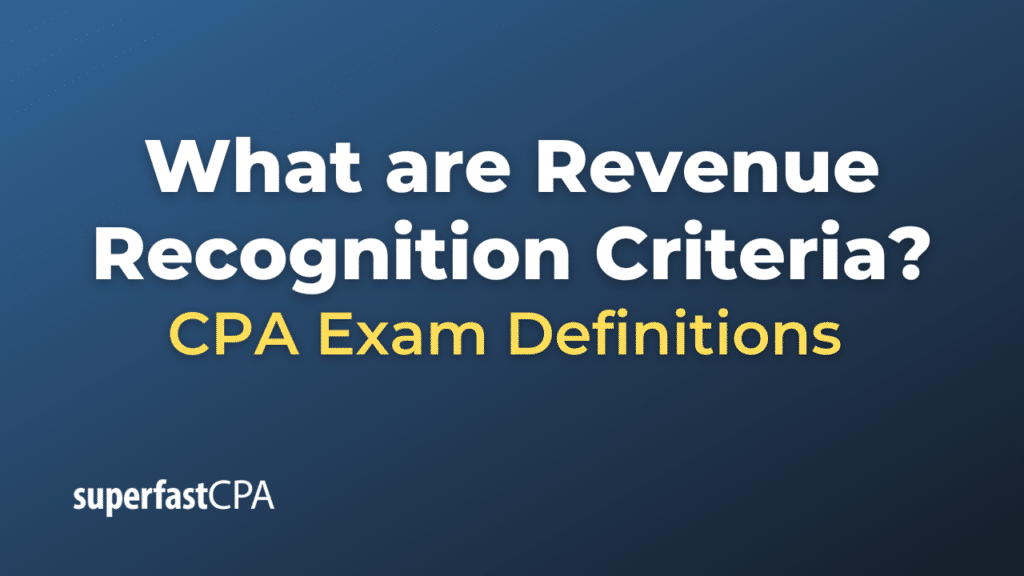Revenue Recognition Criteria
Revenue recognition criteria are the specific conditions that must be met before revenue can be recognized or recorded in the financial statements. These criteria ensure that revenue is recorded in the appropriate accounting period and accurately represents a company’s financial activities.
While revenue recognition criteria can vary depending on the accounting framework (such as the Generally Accepted Accounting Principles, GAAP, in the U.S. or the International Financial Reporting Standards, IFRS, internationally), some fundamental principles remain consistent.
Under the IFRS 15 and ASC 606 (for GAAP) guidelines, which brought more convergence between IFRS and GAAP in terms of revenue recognition, the criteria to recognize revenue from contracts with customers can be summarized in the following five-step model:
- Identify the contract with a customer: A contract exists if there’s an agreement between parties, the parties’ rights can be identified, payment terms can be identified, the parties have committed to fulfilling the contract, and the company expects to collect the consideration.
- Identify the performance obligations in the contract: Break down the contractual agreement into separate promises to deliver goods or services. Each distinct promise is treated as a performance obligation.
- Determine the transaction price: Establish the amount of consideration the company expects to be entitled to in exchange for transferring the promised goods or services.
- Allocate the transaction price to the performance obligations : If a contract has multiple performance obligations, distribute the transaction price among the obligations based on their standalone selling prices.
- Recognize revenue when (or as) the entity satisfies a performance obligation: Revenue is recognized when the customer obtains control of the promised good or service. This can be over time or at a specific point in time, depending on the nature of the good or service.
In addition to the above five-step model, the following criteria also often need to be considered:
- Collectability: The seller must expect that they’ll collect the consideration they’re entitled to (i.e., there’s reasonable assurance that the customer will pay).
- Risk and Rewards: In some frameworks, the significant risks and rewards of ownership of the goods must have been transferred from the seller to the buyer.
- Measurability: The amount of revenue and associated costs must be measurable reliably.
- Completion: It must be probable that the economic benefits from the transaction will flow to the company.
In practical terms, the specific criteria can get more detailed, especially for industries with complex contractual arrangements or multi-element arrangements. Still, the above steps and considerations form the foundation of revenue recognition under modern accounting standards.
Example of Revenue Recognition Criteria
Let’s consider an example of a software company, which can often face intricate revenue recognition situations due to the mix of products and services they provide.
Example: TechSoft Inc.
TechSoft Inc. signs a contract with a client, ABC Corp., to provide:
- A software license valid for three years.
- Custom software development services to tailor the software for ABC Corp’s needs.
- Monthly cloud hosting for the software.
- 24/7 customer support over the contract’s duration.
The total contract price is $360,000, with payment to be made as follows:
- $60,000 upfront.
- $10,000 per month for the next 30 months.
Steps for Revenue Recognition:
- Identify the contract with a customer: TechSoft and ABC Corp. have a signed agreement that creates enforceable rights and obligations.
- Identify the performance obligations:
- Software license for three years.
- Custom software development.
- Monthly cloud hosting.
- 24/7 customer support.
- Determine the transaction price: The total price over the contract period is $360,000.
- Allocate the transaction price to the performance obligations: After evaluating the standalone selling prices of each service, TechSoft allocates the transaction price as:
- Software license: $180,000
- Custom software development: $60,000
- Monthly cloud hosting: $90,000 ($3,000 x 30 months)
- 24/7 customer support: $30,000
- Recognize revenue when (or as) the entity satisfies a performance obligation:
- Software License: The $180,000 for the license is recognized over the three-year term, resulting in a monthly revenue recognition of $5,000.
- Custom Software Development: Assuming the development takes six months, the $60,000 would be recognized over these six months as the work is completed, equating to $10,000 per month.
- Monthly Cloud Hosting: The $3,000 for hosting is recognized monthly as the service is provided.
- 24/7 Customer Support: The support revenue of $30,000 is recognized evenly over the 30 months, resulting in $1,000 recognized per month.
Conclusion:
Across the duration of the contract, TechSoft Inc. will recognize revenue in accordance with the satisfaction of its performance obligations. This approach ensures the company’s financial statements reflect the economic reality of the contract and the services provided to ABC Corp.
In practice, situations can be more intricate, especially with potential changes to contract terms, early terminations, or additional services. However, this example illustrates the fundamental principles of revenue recognition criteria in action.













